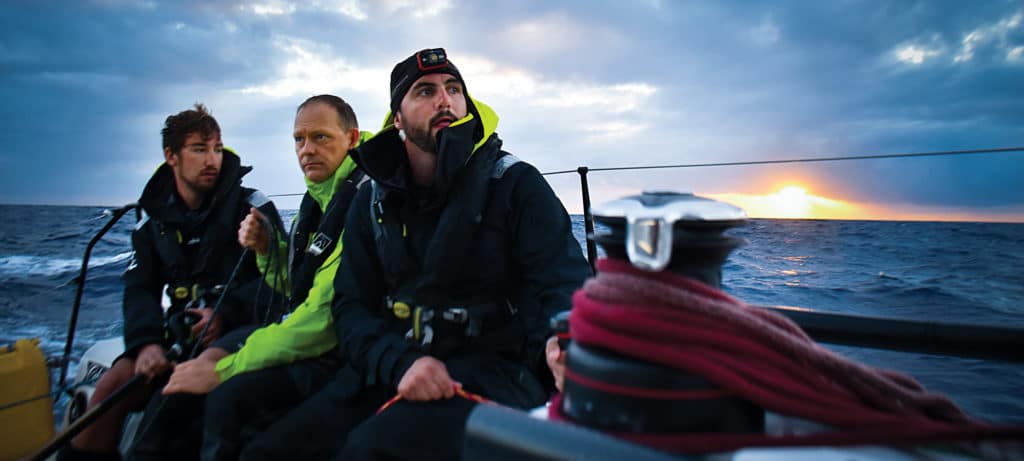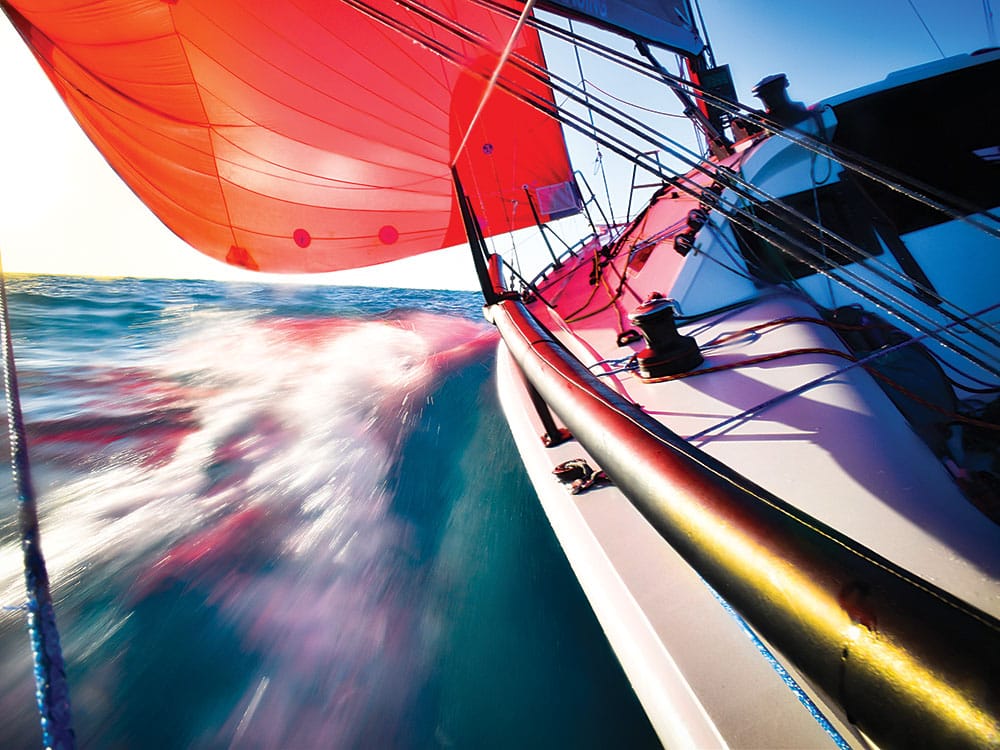
At a late-fall fundraiser for Long Island’s Oakcliff Sailing, on the 49th floor of the downtown Nasdaq building in Manhattan, Ethan Johnson, a sailor at Oakcliff, bends the ear of Oakcliff supporter Lec Maj, assessing his interest in sponsoring a team to sail the 2018 Miami to Havana Race. Maj is intrigued, and after reviewing the numbers with Johnson a few months later, he agrees to sponsor a team to do the race and join them on board as a trimmer.
There’s one problem, though. All of Oakcliff’s nine offshore race boats are 1,317 miles north of Miami, perched on stands, slumbering with a dusting of fresh snow on their shrink-wrap covers. All of them but one: Weegie, a Columbia Carbon 32. It’s on a trailer, ready to hit the road. Johnson rallies a squad, including two of his Oakcliff mates, Sean O’Halloran, who will navigate, and me, serving as onboard reporter and trimmer. He also recruits Webb Institute student Tommy Hickey to trim. It’s a young team with plenty of experience, but none when it comes to racing to the land of cigars and classic cars.
Johnson and O’Halloran haul Weegie nonstop from Oyster Bay, New York, to Delray Beach, Florida, in 23 hours. With the help of Hickey and Maj, they handle most of the prep work while I spend a few extra days in the office before hopping on a plane to meet them on Weegie at Miami’s Key Biscayne YC two days before the start.
When race day arrives, we drag ourselves out of bed at 0430 and hit the road for a 1000 start. We arrive at the starting area, and as a sign of good luck, behold the sight of a whale breaching right on the line. The magnificent creature disappears as we reach across the start in an easy 15-knot breeze.
The five of us on our 32-footer are plenty fast over the ground, but it isn’t long before the race’s larger boats roll on past. “We’re in kind of an awkward combination for Weegie,” says Johnson as we watch them stretch away. “We’re on the crossover from the blast reacher to the code zero. We’re powered up, but the wave sets are really unpredictable right now.”
The wind soon backs, allowing us to drop the code zero and launch the A1.5 spinnaker. The majority of the fleet remains inland to avoid the worst of the Gulf Stream current, but we sneak farther offshore, where, for about an hour, we skirt along with a 1-knot current boost from an underwater back eddy swirling around the drop-off of the continental shelf. Meanwhile, the inland boats plow into a knot of current and sail into a patch of light breeze. With the wind and the water working in our favor, we continue to make gains toward the finish, staying hot on the heels of our main competition on board the race’s two Class 40s: Privateer and Dragon. Dragon had won the two previous editions, so it’s our target to beat.
O’Halloran’s plan is to hug the Florida Keys until we’re ready to cross the Stream before sending it straight to Havana.
“Dragon won last year by going for it super late,” O’Halloran explains. “This year, we’ll have to cross earlier because the wind is supposed to clock east.”
This is the third time Weegie has been this far offshore since being donated to Oakcliff in 2017. Previously, there was the Annapolis to Newport Race and the Chicago Mackinac race, when Johnson and O’Halloran suffered through steep waves and 30 knots on the nose, for hours. Conditions for this race, however, are much more to their liking: 16 knots off the stern quarter, which is enough for the 30-footer to plane down the steep 4-foot waves. These are also the conditions for which the Columbia 32 was made. It was designed to be the smallest boat that could possibly win the Transpac Race from Los Angeles to Honolulu.

With Weegie performing at its best, the crew pumps the sails to keep it planing with every wave, careening headlong into the dark night. We jibe back and forth between the northeast-bound Gulf Stream to port and the Florida Keys to starboard until O’Halloran decides it’s time to make a move toward Cuba. We can barely see anything in the dark, moonless night except for two white lights off our port bow.
“White over white, short tow in sight,” I state aloud. A 700-foot barge extends across the black horizon, and even worse, it’s moving in our direction, pushed along by the tugboat Courageous. Hickey checks its length on the AIS and then checks its closest point of approach. At our current speed, we can cross Courageous a mile ahead, which is the keep-away distance for most commercial vessels.
We continue surfing waves, pushing for every ounce of boatspeed until a spotlight illuminates our sails. The beam is followed by a deep, booming foghorn. It’s Courageous. Hickey hails them on the radio: “Towing vessel Courageous, this is the sailing vessel Weegie. What is your keep-away distance?”
“Our keep away distance is 2 miles,” is the reply. “Please alter your course.”
Allegedly, they were carrying dangerous cargo, which requires a greater keep-away distance. We curse like sailors while O’Halloran weighs our options. Time is ticking. We have to cross the Stream soon or we’ll pay a steep price later. He checks the AIS to see if the Class 40s have crossed, but they are out of range. He grits his teeth and makes the call: “We have to slow down. We have to let Courageous pass.”
It’s an agonizing delay, with each minute lost threatening to drag us down the corrected time slider, but as Courageous’ stern rumbles past, we settle into a fast groove. When Cuba is in our crosshairs, O’Halloran swaps out with Johnson to get some sleep, but just as he starts to doze off — bang! — the spinnaker halyard fails, and the kite cascades silently into the water.
“All hands on deck!” Johnson shouts from the helm. Maj and I scramble into action, tethering and untethering to the jackline as we make our way to the low side. We try to gather the massive sail, but it’s filling with seawater. O’Halloran comes back on deck to lend a hand, hauling the sail out of the water before attaching a second masthead halyard. Maj then hoists it, making for a quick recovery but a costly mishap in a race that requires every minute to be dedicated toward going as fast as possible.
The night wears on; we careen down waves into the dark and tepid Gulf Stream. We are running low on sleep. At 20 knots, it’s impossible to get decent rest in this 32-foot carbon-fiber shell.
The breeze remains a stiff 25 knots with higher gusts, and the waves grow larger and steeper. The entire boat vibrates as we notch a top speed of 22.5 knots. Johnson’s knuckles are truly white as he clenches the tiller with all the concentration he can muster. His eyes are heavy, and while the physical and mental fatigue are setting in, he’s prepared. He grabs a Red Bull for a sugar-laden jolt and plays a careful balance on the helm. Steer too low buries the bow in the wave trough; steer too high and it’s wipeout and cleanup in Aisle 9. But Johnson, Hickey, and O’Halloran are in harmony and keep the rig upright.
The sun rises with an orange glow that stirs a second wind within each of us. A few hours pass before we see Cuba’s hilly outline on the horizon. A few more hours and Havana’s jagged cityscape comes into view. With the home stretch before us, morale is high until we check the AIS to see that Dragon is already returning home from Cuba. They’ve turned-and-burned after finishing the race. They have to beat us by approximately three hours, so Johnson checks our ETA: approximately three hours.
We push our tired bodies to keep the boat as fast as possible on its lines before crossing the finish line with an elapsed time of 25 hours and 32 minutes. A question lingers among us as we clean up the boat for arrival: Our time is good, but will it be enough to slay the Dragon?
We steer toward Marina Hemingway, when, coincidentally, a whale breaches a few hundred feet away. We tie up at our slip, and Johnson and I descend belowdecks for the customs inspection. When we emerge, O’Halloran’s pointer finger is projected skyward, his face bearing a big grin. “Numero uno,” he declares.
Seventeen minutes is the margin of victory, and with that we light up a cigar, roll out the Cuban courtesy flag and lock arms for a picture. All in a day’s work.









